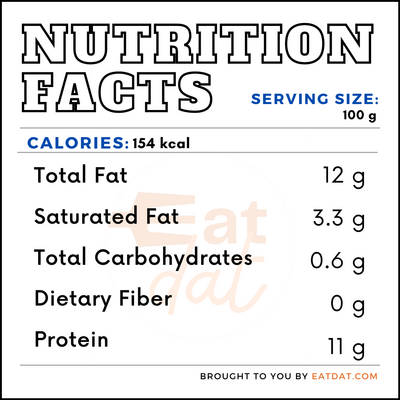
Omelette
What is an Omelette?
An omelette or omelet is a dish made from a mixture of beaten eggs and milk or cream that is fried with butter or oil. Unlike scrambled eggs, this dish is not stirred but instead folded over once fully cooked. The name omelette comes from the Middle French word “oeufmelette”, a combination of the words “amelette” meaning ‘blade’ and “oeuf”’ meaning ‘egg’.
- People use cheese, vegetables, and meat as toppings on this egg-based dish.
- The global market value for eggs reached $200.8 billion in 2019.
Five common types of omelette enjoyed around the world are:
- Khai Chiao, Thailand
- Tamagoyaki, Japan
- Tortilla De Patatas, Spain
- Frittata, Italy
- Omeleta, Greece
Origin of omelette
A version of the omelette has existed in every civilization in the world at one point or another. The Persians and ancient Japanese had their own variations of this food. The Romans also used eggs and dairy products together in their food. One legend states that Napoleon Bonaparte and his army were the first people to eat this meal. As the story goes, they decided to relax in an inn near Bessieres and the owner of the inn prepared an omelet to pay his respect to Napoleon.
Napoleon loved the dish, so he decided to gather all the eggs in the town to make a large omelette for his army. This dish would later evolve in the United States, specifically with the Denver sandwich form, which consisted of two slices of toast with an omelette between them. In the 1900s, this sandwich became quite popular and the Denver omelette came into limelight. This variation consisted of onions, mushrooms, cheese, diced ham, and green pepper. Today, omelettes can still be enjoyed across the globe.
Functions
This dish can be made in many different ways in the kitchen. Often considered a healthy breakfast, omelettes are usually eaten with nutritious vegetables like spinach and carrots. Some individuals may even consume this dish with wines and salads for dinner.
Nutrition
A 100g serving size of omelette offers:

The main ingredient in this food is eggs, which offer the following health benefits:
- This food supplies the body with essential vitamins and minerals.
- It is rich in vitamin A which is good for the eyesight.
- Omelettes can provide protein and amino acids to the body.
- It can raise the high-density lipoprotein (HDL) of the body, which leads to a lower risk of heart disease.
Commercial production
This food is commercially produced on a fully automated production line. First, a machine deposits the egg mixture into tins. Next, a pneumatic system moves the cans into an oven. After this stage, the containers move out of the oven.
Then, the omelette gets removed from the tins. Finally, the tins move to the initial point via a conveyor to get refilled. A Programmable Logic Controller (PLC) controls every step in this production process.
Application
An omelette is easy to make at home following the steps below:
- First, crack the eggs into a bowl. Proceed to beat the eggs with a fork.
- Then, melt butter in a non-stick skillet over low to medium heat.
- Next, pour the eggs into the skillet and let them cook. Don’t stir them.
- After that, move uncooked parts to the center of the pan by tilting the pan.
- Then, place any special ingredients along the middle of the cooked eggs in the pan. Wait for about 1 minute.
- Finally, with the help of a spatula, fold the omelette in half.
One way to store this food is to put it in an airtight container and place it in the fridge. This way, it can last for three to four days. You can also store it in the freezer, where it will last for about four months.
Omelette recipes
The omelette can be adjusted to suit any taste. Here are some popular recipes:
- French Omelette
- Basic Omelette
- Rice-stuffed Omelette with Pickled Cucumber
- Vegetable Omelette
- Crab, Chili, and Herb Omelette
FDA regulation
The Food and Drug Administration has standards of identity for eggs and egg products. The body has regulations concerning the purchase, transportation, storage, preparation, and serving of eggs and related dishes. The FDA has also set up regulations to avoid the contamination of eggs by Salmonella during production, shipping, and storage. They also offer guidelines for consumers to follow while buying, storing, preparing, serving, and transporting eggs. These guidelines are in place to protect people from foodborne illnesses.
References
“Global Egg Market Data and Industry Forecast Analysis.” The Business Research Company, The Business Research Company, Apr. 2020, www.thebusinessresearchcompany.com/report/egg-global-market-report-2020-30-covid-19-impact-and-recovery.
“CFR – Code of Federal Regulations, Title 21.” accessdata.fda.gov, U.S Food And Drug Administration, 1 Apr. 2019, www.accessdata.fda.gov/scripts/cdrh/cfdocs/cfcfr/CFRSearch.cfm?CFRPart=160.
Jaron. “How To Reheat An Omelet (The Best Way).” www.foodsguy.com, Foods Guy blog, 11 June 2020, foodsguy.com/reheat-Omelette/.
“9 Health Benefits of Eating Eggs for Breakfast:” www.keckmedecine.org, Keck Medicine of USC, 8 Sept. 2020, www.keckmedicine.org/10-healthy-benefits-of-eating-eggs-for-breakfast/.
